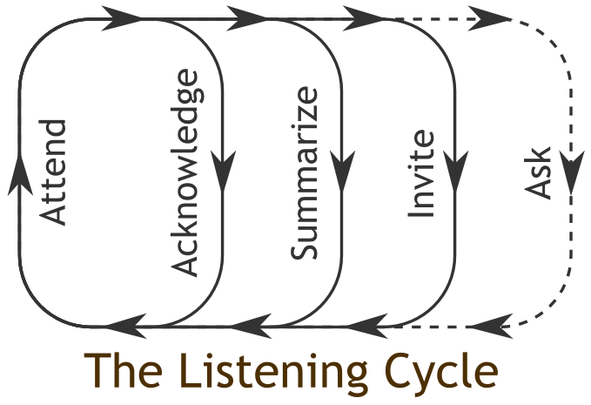
Communication using the Listening Cycle
For years, researchers have studied what effective communication looks like in effective relationships between couples, parents/children, friends, and co-workers. Sherod and Phyllis Miller created a model consisting of The Awareness Wheel and Listening Cycle designed to improve communications in all kinds of relationships. Here is a quick overview of the process:
Rules for the both of you:
The Listening Cycle Diagram was developed by:
Miller, Sherod, Phyllis Miller, Elam W. Nunnally, and Daniel B. Wackman. Talking and Listening Together: Couple Communication I. Littleton, Colo.: Interpersonal Communication Programs, 1991. Print.
The Listening CycleThe listener (from above) will actively respond to what the speaker is saying by following the listening cycle using the second person, "You" statements.
Attend Give full attention to the speaker - Look, Listen, Track
Acknowledge what the speaker says. This is often done through nods, "brief statements," "uh-huh," etc. to show the speaker you are tracking their content and non-verbals.
Summarize without editorializing or giving opinions to ensure accuracy. Focus especially on needs and wants. Don't leave it at "I understand," but demonstrate in your summary that you heard what they said.
Invite more information to make sure you have the whole picture. Ask, "Did I get all the important points?" "Is there anything you would like to add?" "Is there anything more you'd like me to know?
Use questions sparingly and only for clarification. Make them open-ended.
For years, researchers have studied what effective communication looks like in effective relationships between couples, parents/children, friends, and co-workers. Sherod and Phyllis Miller created a model consisting of The Awareness Wheel and Listening Cycle designed to improve communications in all kinds of relationships. Here is a quick overview of the process:
Rules for the both of you:
- The speaker has the floor. Don't cut off the speaker or finish his or her sentences.
- Share the floor (take turns)
- No problem solving
- Make "I" statements, Speak for yourself and avoid telling the other what they think or feel
- Share your feelings without putting down the other person
- Be specific and brief about your perceptions and feelings (2 - 3 sentences)
- Stop and allow your listener to tell you what they heard you say. If they didn't accurately head what you said, state what was not heard in a polite way.)
- Be open to letting what the other person says change you. You won't be able to listen effectively if you are in a protective emotional state like "Anger", "Fear" or "Panic". See the Feeling Words List
- Always start by stating the issue--which stays the same until it is resolved. Keep the focus paraphrase on what the speaker said, not a rebuttal. Wait until you are the speaker to give your thoughts.
- After the paraphrase, ask the speaker "Is that right?" or "Did I miss anything?"
The Listening Cycle Diagram was developed by:
Miller, Sherod, Phyllis Miller, Elam W. Nunnally, and Daniel B. Wackman. Talking and Listening Together: Couple Communication I. Littleton, Colo.: Interpersonal Communication Programs, 1991. Print.
The Listening CycleThe listener (from above) will actively respond to what the speaker is saying by following the listening cycle using the second person, "You" statements.
Attend Give full attention to the speaker - Look, Listen, Track
Acknowledge what the speaker says. This is often done through nods, "brief statements," "uh-huh," etc. to show the speaker you are tracking their content and non-verbals.
Summarize without editorializing or giving opinions to ensure accuracy. Focus especially on needs and wants. Don't leave it at "I understand," but demonstrate in your summary that you heard what they said.
Invite more information to make sure you have the whole picture. Ask, "Did I get all the important points?" "Is there anything you would like to add?" "Is there anything more you'd like me to know?
Use questions sparingly and only for clarification. Make them open-ended.
